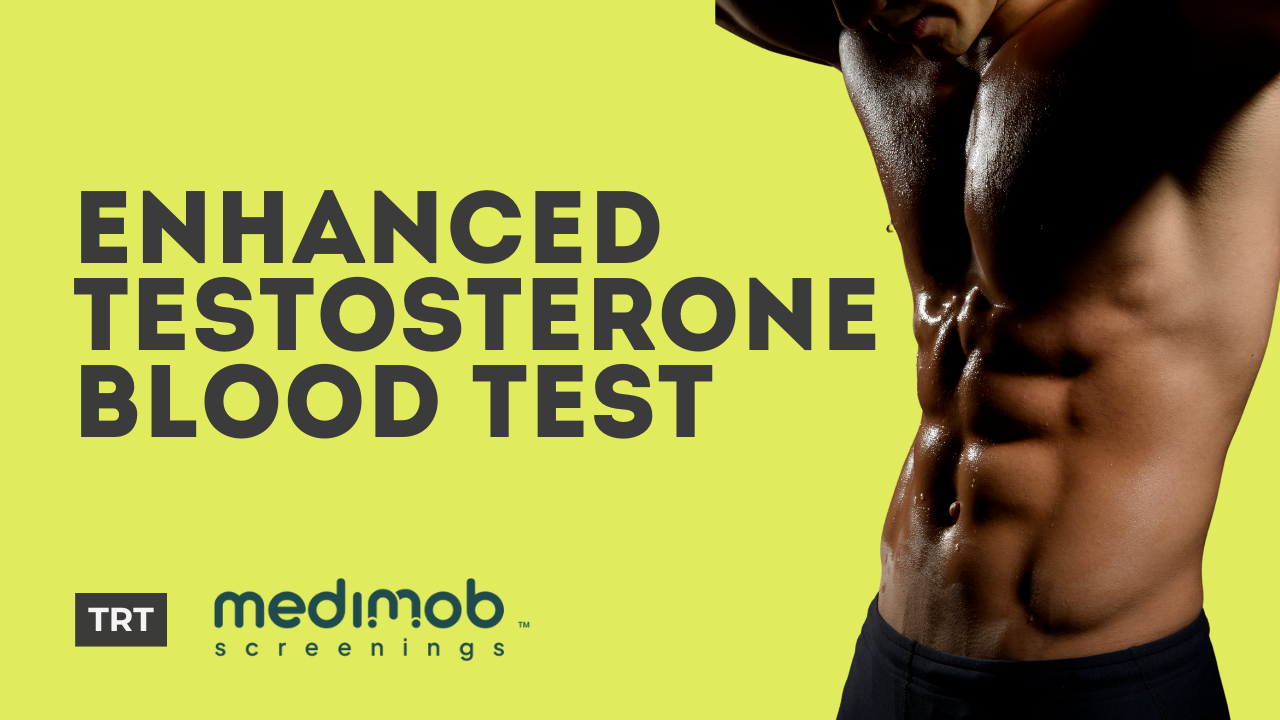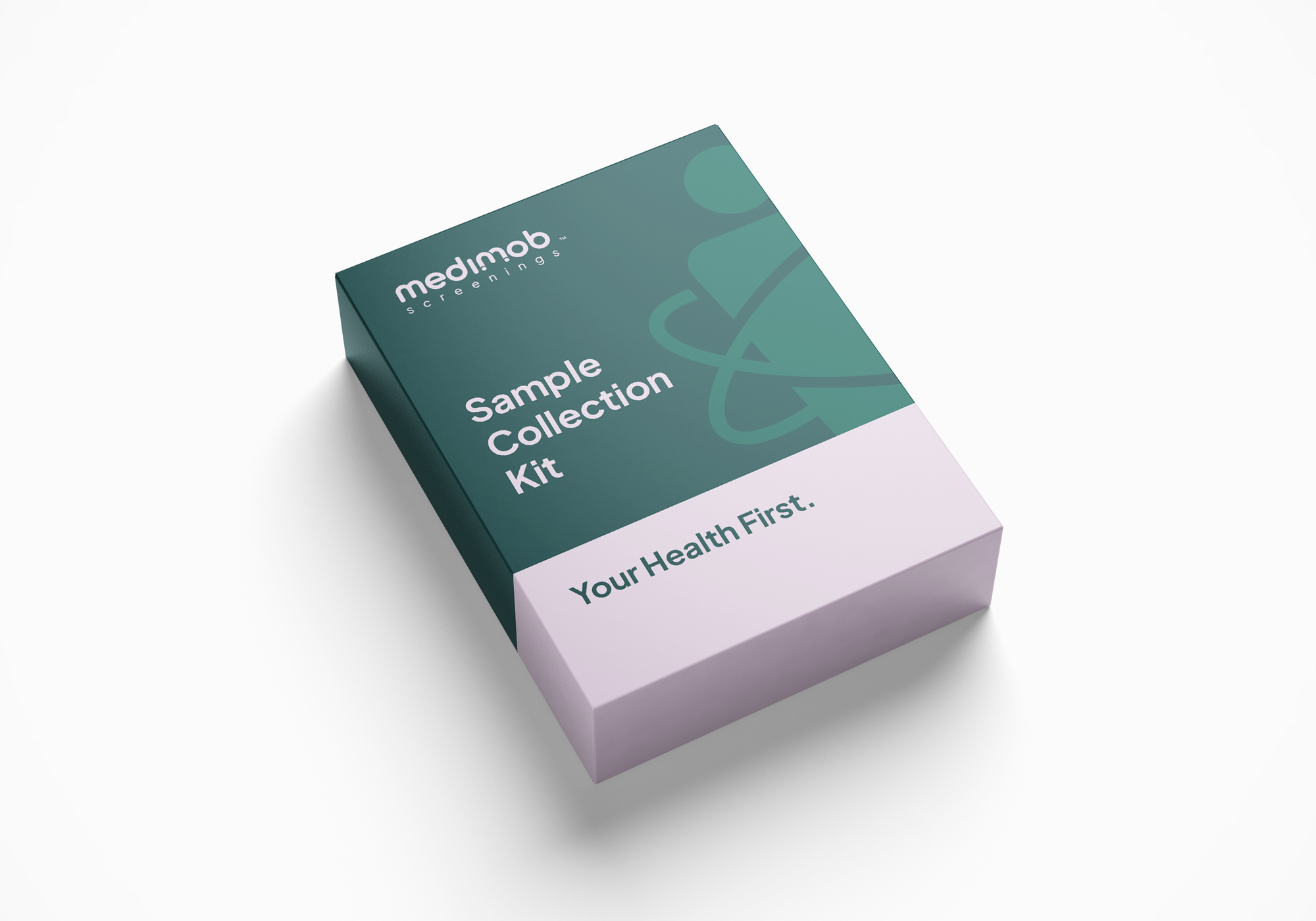Enhanced Testosterone Blood Test In TRT
Discover why a standard testosterone test isn't enough. Our Enhanced TRT Blood Test covers hormones, prostate markers, and organ health to keep your therapy effective and safe.

Testosterone Replacement Therapy (TRT) continues to gain traction among men experiencing symptoms of low testosterone, also known as hypogonadism. Rising awareness of fatigue, low libido, muscle weakness, mood disturbances, and decreased bone density has propelled TRT into the spotlight as a therapeutic option to alleviate these conditions. However, testosterone is more than just a sex hormone. It influences key physiological systems, and altering its levels can have far-reaching effects. Without thorough, ongoing monitoring, TRT can carry risks that potentially outweigh its benefits.
An enhanced testosterone blood test ensures your hormone therapy isn’t just effective but it is also safe. By measuring not only testosterone but also hormones like SHBG, oestradiol, luteinising hormone (LH), follicle-stimulating hormone (FSH), and prolactin, as well as prostate markers and metabolic health indicators, this panel helps guide precision treatment decisions. It also assesses organ function (liver, kidney, blood parameters, lipids, and thyroid), protecting against common side effects of testosterone therapy.
What Is TRT and Who Needs It?
TRT stands for Testosterone Replacement Therapy. It is a medical intervention used by men (and sometimes women) with persistently low testosterone levels that are both clinically documented and cause distressing symptoms. It is primarily prescribed for hypogonadism, either primary (testicular failure) or secondary (pituitary dysfunction). The goal is to restore serum testosterone to mid-normal range and reverse symptoms that degrade quality of life. TRT is often administered via gels, injections, patches, or implants under medical supervision.
Testosterone deficiency can occur at any age but predominates in older men. Estimates suggest 5–12% of men over 50 may have clinically low levels, and among patients presenting with fatigue or sexual dysfunction, prevalence rates can exceed 20% (Bhasin et al., 2018). Confirmation of deficiency requires measuring total testosterone morning levels on two occasions, along with assessment of free testosterone or SHBG, especially when total levels fall within the borderline range (Grossmann & Matsumoto, 2020).
Over-the-counter and online access to testosterone has blurred lines between clinical treatment and self-experimentation. Yet despite its growing popularity, TRT is not suitable for everyone. Men with untreated prostate cancer, breast cancer, or severe heart failure are typically advised against testosterone therapy. Those undergoing TRT require careful medical evaluation and ongoing blood tests to evaluate therapy efficacy, side effects, and long-term risks (Traish et al., 2021).
Enhanced Testosterone Blood Test | Fast Results
The Limitations of Measuring Only Testosterone
Traditional TRT monitoring often focuses exclusively on serum testosterone. While essential, relying only on this one measure risks overlooking important physiological shifts. Total testosterone captures both protein-bound and free hormone, but free testosterone better reflects the bioactive form that exerts effects on cells. SHBG binds testosterone and alters free fractions; thus, measuring both total and free testosterone offers clarity.
Restricting labs to testosterone also fails to account for oestradiol conversion, prostate impact, red blood cell mass, liver strain, or cardiovascular risk factors. Elevated haematocrit (a common side effect) can increase the likelihood of blood clots; excessive oestradiol may cause gynecomastia or emotional lability. Moreover, testosterone can upregulate prostate-specific antigen (PSA), confusing prostate health interpretation. A panel without these elements misses crucial dimensions of safe TRT and limits clinical decisions.
Why We Need an Advanced TRT Blood Test
An Advanced TRT Blood Test integrates multiple hormones and biochemical markers to provide a holistic view of therapy's physiological impact. Rather than piecemeal data, it synthesises a comprehensive snapshot across endocrine, haematological, metabolic, hepatic, renal, and prostate health.
This testing paradigm aligns with guidance from leading medical organisations. The American Urological Association (AUA) and Endocrine Society recommend baseline labs before starting TRT, including testosterone, PSA, hematocrit, and liver enzymes, followed by retesting 3–6 months into therapy and annually thereafter (Bhasin et al., 2018; Corona et al., 2019). An enhanced panel incorporating lipid, thyroid, and inflammatory markers pushes safety and optimisation further.
Enhanced Testosterone Blood Test | Fast Results
Key Hormonal Biomarkers in the Panel
1. Total Testosterone and Free Testosterone
Total testosterone measures overall hormone concentration, while free testosterone indicates biologically available hormone not bound to SHBG or albumin. Both are critical: total testosterone ensures appropriate dosing, while free testosterone monitors bioactive exposure and treatment response (Grossmann & Matsumoto, 2020). Doctors use these measures to diagnose hypogonadism, confirm treatment success, or detect supraphysiological dosing.
2. Sex Hormone Binding Globulin (SHBG)
SHBG binds testosterone and thyroid hormones. High SHBG lowers free testosterone, often despite normal total testosterone. Conversely, low SHBG increases bioavailable testosterone and raises acne or cardiovascular dysregulation risk. Measuring SHBG allows clinicians to adjust dosing appropriately, particularly in patients with obesity, insulin resistance, or liver dysfunction where SHBG may be altered (Elliott & Morrison, 2018).
3. Luteinising Hormone (LH) and Follicle-Stimulating Hormone (FSH)
LH and FSH assess the activity of the hypothalamic-pituitary-gonadal (HPG) axis. In men on exogenous TRT, LH and FSH should be suppressed; failure to suppress may suggest insufficient dosing or endogenous testicular stimulation. Monitoring LH/FSH is also crucial for men concerned about fertility or seeking to preserve spermatogenesis (Ramasamy et al., 2015).
4. Oestradiol (E2)
Testosterone can be aromatised into oestradiol. Optimal oestradiol supports bone density, mood, and libido, but excess can cause gynecomastia, mood swings, or water retention. Measurement enables aromatase inhibitors to target estrogen excess, ensuring hormonal balance during TRT (Safarinejad, 2010).
5. Prolactin
Prolactin levels influence sexual function and libido. Elevation may signal pituitary adenomas or medication interactions. Monitoring prolactin helps detect neurologic or endocrine conditions that could modulate TRT effectiveness or safety (Muller et al., 2008).
6. Prostate-Specific Antigen (PSA)
PSA screening before initiating TRT screens for undiagnosed prostate disease. Testosterone may modestly elevate PSA, so ongoing monitoring is crucial. Sudden PSA increases require urological referral. AUA advises PSA tests at baseline, 3-6 months into treatment, and annually thereafter (Khera et al., 2016).
Hematological Biomarkers: Safety First
1. Hemoglobin and Hematocrit
Increased red blood cell concentration (hematocrit and hemoglobin) is a common side effect of TRT due to testosterone stimulating erythropoiesis. While it can improve anemia, exaggerated increases risk clot formation. Hematocrit over 54% often prompts dose reduction, treatment pause, or therapeutic phlebotomy to maintain safe blood viscosity (Corona et al., 2019).
2. Red Cell Indices (MCV, MCH, RDW)
Mean cell volume, mean cell hemoglobin, and red cell distribution width help evaluate anemia or bone marrow response. They provide early flags for nutritional deficiencies or abnormal red cell morphology.
3. White Blood Cells and Platelets
Monitoring WBCs and platelets identifies underlying infection, inflammation, or clotting disorders. Platelets also contribute to stroke and thrombotic risk profiles.
Metabolic and Organ Function
1. Lipid Profile
Testosterone therapy may decrease HDL cholesterol but sometimes improves insulin sensitivity. LDL cholesterol and triglycerides must be monitored, especially with injection-based therapy, as some studies show mixed cardiovascular results (Traish et al., 2021). LDL elevations may warrant dietary adjustments or statin therapy.
2. Liver Enzymes (ALT, AST, GGT)
Testosterone can influence liver metabolism, especially with oral or high-dose injections. Periodic checks of AST, ALT and GGT help detect hepatocellular stress or toxicity.
3. Kidney Function (Urea, Creatinine, eGFR)
Exogenous testosterone may cause fluid retention, affecting kidney perfusion. Monitoring urea, creatinine, and estimated glomerular filtration rate (eGFR) safeguards against kidney strain, especially in older or hypertensive men.
4. Diabetes and Iron (HbA1c, Ferritin)
HbA1c provides long-term glycemic status. TRT often improves insulin resistance, but potential changes require tracking. Ferritin and iron panels ensure anabolic red cell stimulation doesn’t exhaust iron stores.
Thyroid, Inflammation, and Other Biomarkers
1. Thyroid Hormones (TSH, Free T4)
Testosterone can alter thyroid hormone binding and metabolic rate. Hypo- or hyperthyroid symptoms (e.g. fatigue, cold intolerance) may surface. Monitoring TSH and free T4 supports comprehensive endocrine oversight, particularly in men taking thyroid meds like levothyroxine or liothyronine.
2. Inflammatory Markers (CRP)
C-reactive protein (CRP) indicates systemic inflammation, often higher in metabolic syndrome or cardiovascular disease. A high baseline or increasing CRP warrants cardiovascular risk discussion.
Enhanced Testosterone Blood Test | Fast Results
How the Enhanced Testosterone Blood Test Complements Clinical Care
By integrating endocrine, hematologic, metabolic, and organ health markers, Meidmob's Enhanced Testosterone Blood Test offers clinicians actionable insights. For example, a man with HbA1c creeping upward during TRT can receive dietary and medication advice. An elevated hematocrit may prompt a dosage adjustment before clot risk arises. Rising LDL or liver enzymes can trigger statins or repeating labs before changes escalate. Crucially, no single marker stands alone; patterns are considered alongside patient health, family history, lifestyle, and symptoms.
Managing Side Effects With Lab Insights
High Oestradiol Levels
Frequently, high estradiol emerges in TRT as testosterone aromatises. Symptoms such as gynaecomastia, fluid retention, fatigue warrant treatment tweaks, aromatase inhibitor prescription, or dosage adjustment. The panel provides essential context to decide if estradiol is in a safe mid-range.
Polycythemia Risk
Elevated hematocrit increases risk of thrombosis. Identifying a rise lets clinicians lower doses, adjust injection intervals, or refer for therapeutic blood donation, significantly reducing risk.
Prostate Concerns
Sudden PSA elevations, absent other causes, may indicate benign prostate enlargement or malignancy. Informed PSA testing (timed and baseline-adjusted) avoids unnecessary prostate workups while catching pathology early.
Implementation and Results Interpretation
Frequency of Testing
According to evidence-based guidelines, the initial lab work should be collected before therapy, with follow-up at 3–6 months, and annually thereafter if stable. Those with risk factors (age, cardiovascular history, prostate conditions, polycythemia risk) may undergo more frequent monitoring every 3–4 months (Bhasin et al., 2018).
Understanding Your Report
Numeric ranges are provided for each biomarker, usually stratified by sex and age. Values slightly outside reference ranges may be normal; trends over time are often more telling than single readings. The lab report should be interpreted in consultation with your clinician, not in isolation.
Making Treatment Adjustments
- Low testosterone/Free testosterone: Consider increasing dose or switching to a more consistent delivery method.
- High haematocrit/hemoglobin: Hydration, dose reduction, or phlebotomy.
- High oestradiol: Add or increase aromatase inhibitor, reassess dosing.
- Elevated liver enzymes: Evaluate alcohol intake, injection site changes, medication interactions.
- Adverse lipid profile: Dietary adjustment, inclination for statins.
- Abnormal thyroid markers: Coordinate with endocrinologist, check medication timing.
Enhanced Testosterone Blood Test | Fast Results
Frequently Asked Questions (FAQs)
- Why take an advanced TRT panel instead of a basic testosterone test?
Because testosterone interacts with multiple body systems. A limited panel misses key safety markers like prostate risk or blood viscosity, and impedes personalized dosing. - Can women use this test?
Yes. While primarily used for men with low testosterone, transgender men or women with specific hormonal conditions may also benefit, though reference ranges and interpretation differ. - What is the typical cost?
Costs vary by provider. Comprehensive panels may range from $150–$300, comparable to multiple individual lab tests. - Is fasting required?
No, though avoiding fatty-rich meals, alcohol, and vigorous exercise in the preceding 24 hours helps stabilize markers. - Can medications interfere with results?
Yes. Thyroid medication timing, biotin supplements, testosterone gel contamination, liver meds, or blood thinners can skew readings. Follow instructions closely and note these in lab requests. - How do I ensure accurate results?
Take your sample between 6–10am, before your next dose, avoid conflicting supplements/foods/exercise, and report any recent infections or medical procedures.
Long-Term TRT: Balancing Efficacy and Safety
Scientific evidence shows TRT can boost sexual function, bone density, muscle strength, energy levels, and mood, and may improve anemia and insulin sensitivity (Bhasin et al., 2018). However, decision-making should balance benefits against risks, especially in cardiovascular, hematologic, and prostate domains. An advanced lab panel allows nuanced evaluation and early intervention, supporting both short-term symptom relief and long-term health optimization.
Conclusion and Take-Home Message
Testosterone therapy offers life-changing benefits for men with low sexual function, fatigue, or metabolic decline, but only when used with caution, personalisation, and regular monitoring. The Advanced TRT Blood Test goes beyond single-hormone tracking and places safety, efficacy, and systemic health at its core. It provides a data-driven roadmap for treatment, allowing early detection and resolution of side effects before they escalate.
For patients and clinicians navigating TRT, this comprehensive panel is an invaluable tool, enabling confident, evidence-based management that supports both immediate symptom improvement and lifelong health.
References
Bhasin, S., Brito, J.P., & Cunningham, G.R. et al. (2018) Testosterone therapy in men with hypogonadism: An Endocrine Society clinical practice guideline. Journal of Clinical Endocrinology & Metabolism, 103(5), pp.1715–1744.
Bhasin, S. et al. (2018) Testosterone therapy in adult men with androgen deficiency syndromes: An Endocrine Society clinical practice guideline update. Journal of Clinical Endocrinology & Metabolism, 103(5), pp.1715–1744.
Corona, G. et al. (2019) Thrombocytosis and Polycythemia During Testosterone Replacement Therapy: Utility of Therapeutic Phlebotomy. Andrology, 7(1), pp.110–119.
Elliott, H.L., & Morrison, W.L. (2018) The role of sex hormone binding globulin. Clinical Endocrinology, 14(6), pp.611–619.
Grossmann, M., & Matsumoto, A.M. (2020) A critical appraisal of testosterone replacement therapy in men. New England Journal of Medicine, 382(6), pp.539–547.
Khera, M. et al. (2016) Testosterone replacement therapy and prostate cancer risk: A systematic review and meta-analysis. American Journal of Men’s Health, 10(5), pp.Machine Crosscheck.
Muller, A. et al. (2008) Prolactin and male sexual function. Journal of Endocrinological Investigation, 31(9), pp.784–788.
Ramasamy, R. et al. (2015) LH, FSH, and endocrine markers of pituitary testicular axis function. International Journal of Endocrinology, 2015, Article ID 813706.
Safarinejad, M.R. (2010) Effect of testosterone replacement therapy on male hormonal profile and symptoms: A randomized study. European Urology, 58(4), pp.620–628.
Traish, A.M. et al. (2021) The rediscovery of testosterone. Journal of Andrology, 42(3), pp.e12940.
Enhanced Testosterone Blood Test | Fast Results


